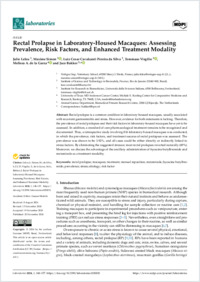Rectal prolapse in laboratory-housed macaques : prevalence, risk factors, and enhanced treatment modality
- Leleu, Julie VetAgro Sup, Veterinary School, Marcy L’Etoile, France
- Simon, Maxime VetAgro Sup, Veterinary School, Marcy L’Etoile, France
- Cavalcanti Pereira da Silva, Luiz Cesar Institute of Science and Technology in Biomodels, Fiocruz, Rio de Janeiro, Brazil
- Virgilio, Tommaso ORCID Institute for Research in Biomedicine (IRB), Faculty of Biomedical Sciences, Università della Svizzera italiana, Switzerland
- De la Garza, Melissa A. University of Texas MD Anderson Cancer Center, Michale E. Keeling Center for Comparative Medicine and Research, Bastrop, USA
- Bakker, Jaco Animal Science Department, Biomedical Primate Research Centre, Rijswijk, The Netherlands
- 2024
Published in:
- Laboratories. - 2024, vol. 1, no. 3, p. 148-157
Rectal prolapse
Macaques
Treatment
Manual reposition
Metamizole
Hyoscine butylbromide
Prevalence
Stress
Etiology
Risk factor
English
Rectal prolapse is a common condition in laboratory-housed macaques, usually associated with recurrent gastroenteritis and stress. However, evidence for both statements is lacking. Therefore, the prevalence of rectal prolapses and their risk factors in laboratory-housed macaques have yet to be assessed. In addition, a standard of care pharmacological treatment remains to be recognized and documented. Thus, a retrospective study involving 816 laboratory-housed macaques was conducted, in which the prevalence, risk factors, and treatment success of rectal prolapses was assessed. The prevalence was shown to be 3.92%, and all cases could be either directly or indirectly linked to stress factors. By eliminating the suggested stressor, most rectal prolapses reverted naturally (69%). Moreover, we discuss the advantage of the ancillary administration of hyoscine butylbromide and metamizole as a treatment modality.
- Collections
- Language
-
- English
- Classification
- Medicine
- License
- Open access status
- gold
- Identifiers
-
- DOI 10.3390/laboratories1030012
- ARK ark:/12658/srd1332084
- Persistent URL
- https://n2t.net/ark:/12658/srd1332084
Statistics
Document views: 67
File downloads:
- Virgilio_2024_MDPI_laboratories_Rectal prolapse: 25
